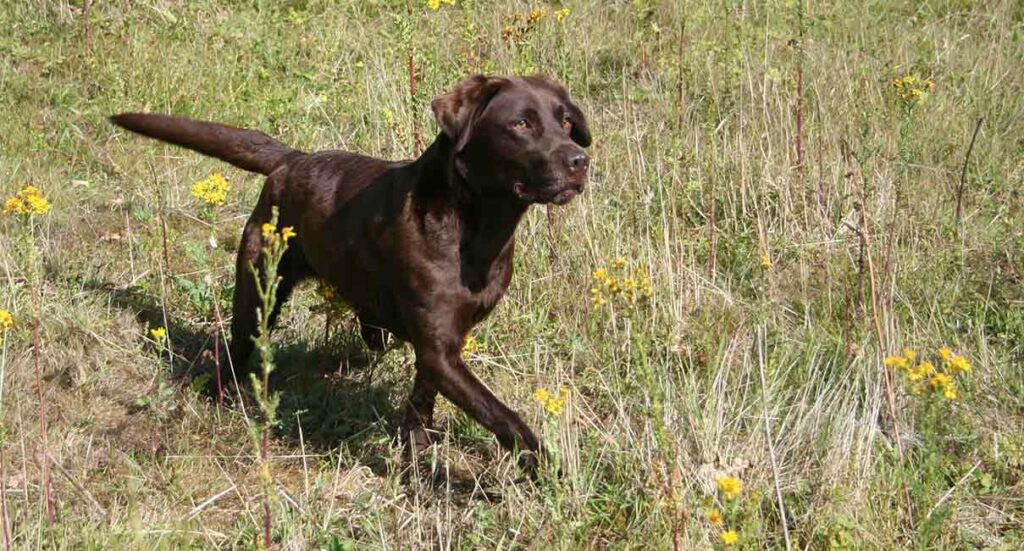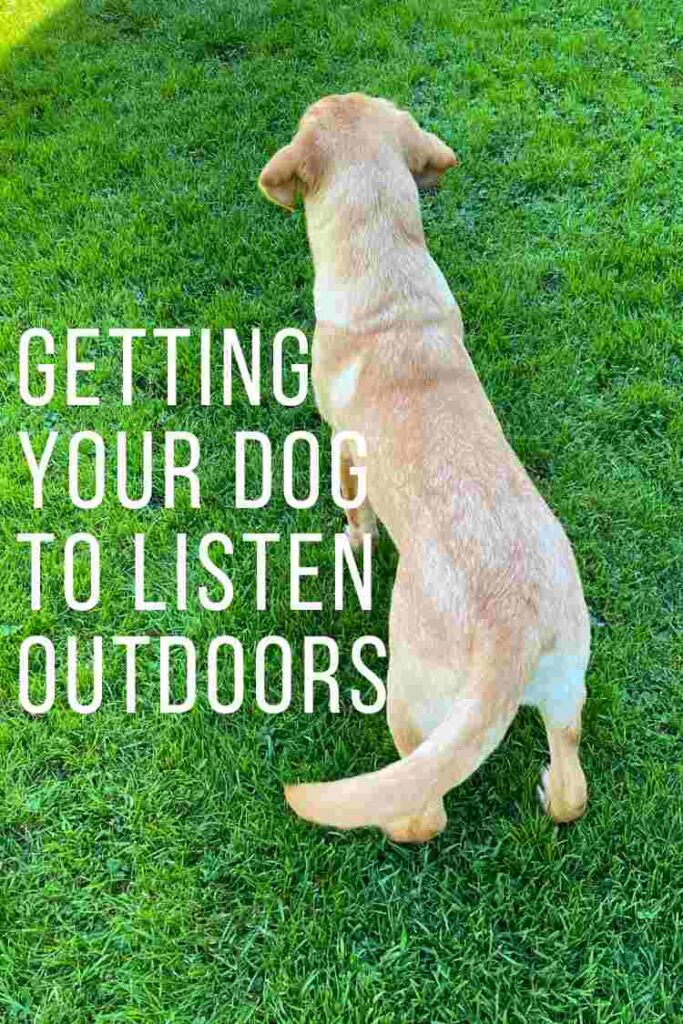Many dogs have the amazing ability to transform themselves from loving, and devoted companions, into devil-may-care tearaways when they are released outdoors. And getting a dog to listen outdoors can be extremely challenging if you don’t know the right way to go about it.

So what is it about being outside, that turns a good dog into a naughty dog with an advanced case of acute (albeit temporary) hearing loss?
Is there something about running off-leash that renders dogs incapable of listening. Is it the open spaces or all that ultra violet light? Is it the breeze, wafting interesting smells up that sensitive nose? Or the glimpse of another dog on the horizon?
The truth is, it’s all of those things. And it’s none of them.
At the heart of your dog’s failure to listen there is usually a combination of poor motivation and an incomplete training process. Let’s take a closer look at those.
Dogs need motivation too!
Imagine I had just taught you to tie a specific kind of knot. One of those fancy knots that boaty people use – my husband is a big fan of these.
So I teach you to tie the knot sitting at my kitchen table, and I tell you that to earn a small piece of candy you need to tie that knot within 5 seconds. It takes you a few goes, and you’ve got it. You enjoy the candy, I undo the knot, and ask you to tie it again. This time you do it in 3 seconds, easy.
Obviously this is more likely to work if you like candy, and if you are fairly bored.
What if some of your best friends come around, and I wander up with my candy and my bit of string. Do you still want to play my knot game. Maybe not.
Your friends are a distraction and you’d rather hang out with them than play my silly game.
But what if I had given you a thousand dollars each time we played in the kitchen before your friends came around?
In that case, you might say “hang on guys, I’ll be with you when I’ve tied this knot” And tie the knot for me anyway. You’d do this because your motivation is so much higher.
This isn’t exactly what happens when we are training dogs. But the principle is the same. When we learn something new at home, if the rewards are high to begin with, we’re more likely to attempt that task in a more distracting situation, than if the rewards previously given were really mean.
If your dog has been rewarded with something that they value highly when playing your game in the past, they are more likely to try harder to work with you when you make the game harder. And responding to your cues outside is much harder for dogs because of all those distractions I talked about at the beginning of this article.
Takeaway #1
So the takeaway here is that you need to practice the cues you want your dog to respond to outdoors, and you need to do this at home with high value rewards first. So that your dog is motivated to keep responding to your cues when the going gets tough.
Your second task is to teach your dog to respond during distractions, in stages. And here’s why.
Learning is context specific
Dogs have much more limited ability to generalise than we humans.
If I took you to the middle of a busy mall or fairground, or some kind of rally where lots of people are gathered, you would still be able to tie my knot and earn your thousand dollars. Though you might be a bit slower. You’d also be able to tie that knot on a train, or a boat, and you’d be able to do it lying down or standing up.
If I put you in danger, you might lose your knot tying skills, but on the whole humans have the ability to take a skill learned in one context, and apply it in another.
Dogs on the other hand really struggle with this. And the way around that problem is to introduce distractions in stages.
“But wait Pippa!” You say. “My dog obeys me at home, but not at the dog park. How can I possibly take my dog to the park, in stages?”
That’s a good point. And we have a few ways to get around this problem.
Distraction training at home
Fortunately, learning to respond to cues under distractions is something that dogs get better at with practice. Even if the distractions are not the same each time.
For example, when we teach dogs to ‘sit-stay’ some of the very simple distractions we can provide at home, in the kitchen, help the dog cope with the greater distractions at the dog park in the future.
Simple distractions like teaching the dog to sit and stay while you march on the spot or sit on the floor and get up again, all help your dog’s understanding that the sit cue always means sit until you are released, no matter how strangely people around them are behaving.
This process of introducing distractions in easy stages is called proofing. And it is the most important part of any dog training process because it helps your dog to thoroughly understand what your cues really mean.
It is also the most neglected part of most dogs’ education. But it needn’t be!
There are so many simple games you can play that help teach your dog how to resist temptation. You’ll find lots of examples of these in our Core Skills Course. And it isn’t difficult to invent your own games once you have played a few and learned the principles involved.
Diluting distractions outdoors
Another way to help dogs understand cues in different contexts, is to dilute the distractions posed outdoors. For example, you could teach your dog to walk nicely on a loose leash at a distance from other dogs, before asking your dog to do the same, closer to them.
Diluting distractions is often easiest to achieve by adding distance, but where that’s not possible, we can teach the dog to carry out a simpler task in the presence of the distraction first. For example, you can ask your dog for a hand touch, or even just some eye contact, when there are other dogs around. Rather than diving straight in with heelwork or recalls.
And don’t forget those high value rewards so that the dog learns that it’s worth paying attention to you even when there are other fun things going on.
Of course, many dogs will always prefer chasing squirrels to sitting next to you being fed cubes of their favorite cheese. So how does training with high value treats help you when you can’t compete with the alternative rewards available outdoors for your dog? Let’s look at that next.

Preventing accidental reinforcement
One of the reasons that many dogs become disobedient outdoors, is because they learn that disobedience at the dog park is very rewarding. There’s nothing quite like the buzz of a good squirrel chase, or a brilliant game with another friendly dog.
These accidental rewards play havoc with your training because they teach the dog that not listening is a great option. And it’s critical during any dog training program, that all rewards come from you and are planned by you. So that we build the behaviors we want, and allow undesirable behaviors to die out.
One way to avoid accidental reinforcement is to practice with the dog on a long line. This enables us to build up the dog’s distraction-resisting abilities in the new contexts we take them to and ensure that only the correct responses to our cues are rewarded.
Once the dog has a really strong history of responding to cues in distracting environments, those responses become deeply ingrained and reliable, and with many dogs, you will eventually be able to trust them off-leash again.
Takeaway #2
Introducing distractions in structured steps is the key to a dog that listens and obeys outdoors. Take your time over the proofing process, and make sure your dog cannot help themselves to rewards that you don’t have control over.
And if your dog is struggling with distractions take a moment to think about ways of making the task a little easier or a little less distracting for them.
Of course there is more to keeping a dog’s attention and focus on you in the outside world than just rewards and practicing ignoring distractions in stages. Those that have the most attentive dogs put a lot of effort into being interesting to their dogs, and in interacting with them.
Take a ball on your walk, or a frisby and encourage your dog to play. Break your walk up by playing a little training game every fifteen minutes or so. And try to anticipate problems, other walkers approaching for example, and be prepared for distractions, even avoid them if necessary.
We’ll talk about some of these in more detail another time. Meanwhile, enjoy your training. And if you need help, drop into our Facebook support group and have a chat with our team. We’d love to see you there!

Free Training Tips
Get Pippa's free dog training tips delivered to your inbox

 Dog Training Treat Bags – This Is What I Use And Why
Dog Training Treat Bags – This Is What I Use And Why